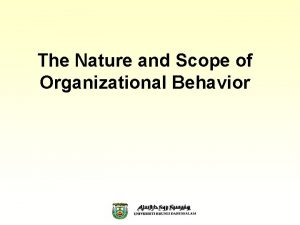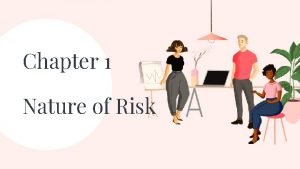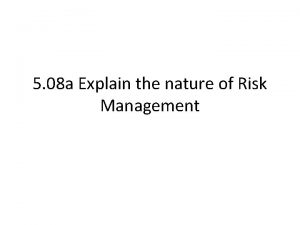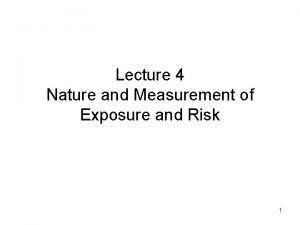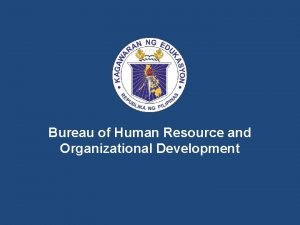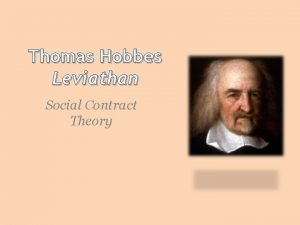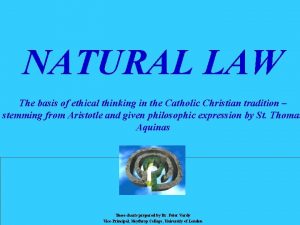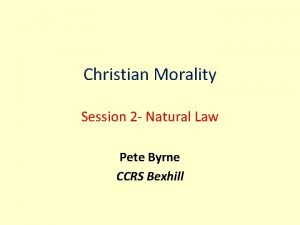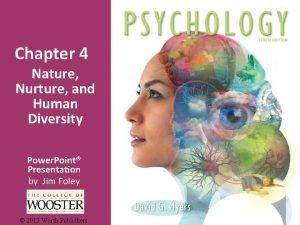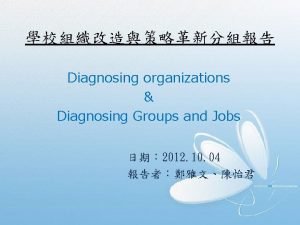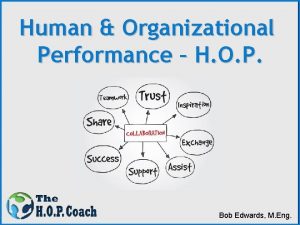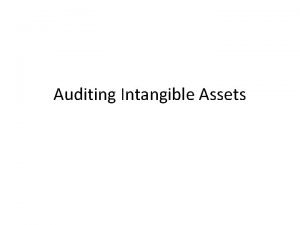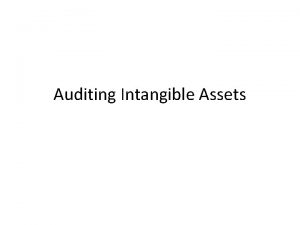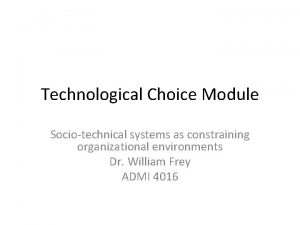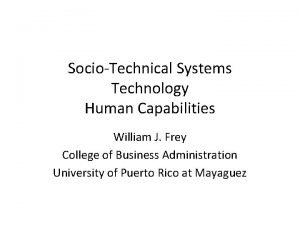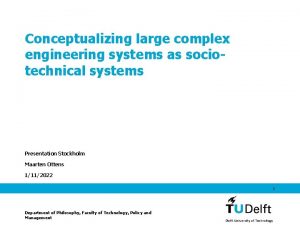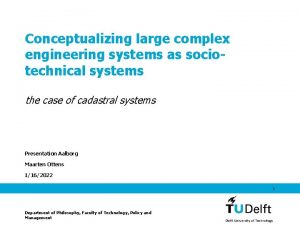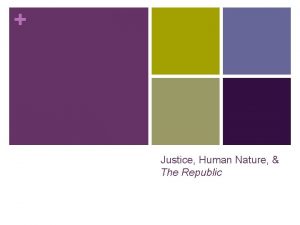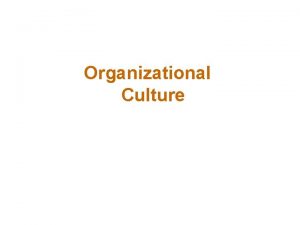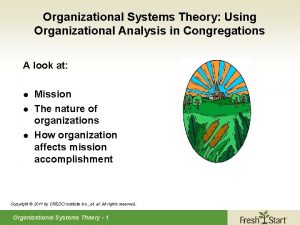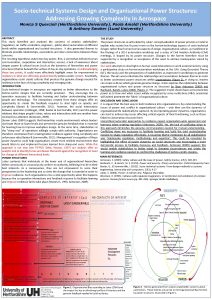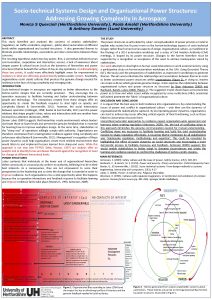Organizational Risk Analysis Human Nature and SocioTechnical Systems






























- Slides: 30

Organizational Risk Analysis: Human Nature and Socio-Technical Systems John S. Carroll MIT Sloan School presented at 16. 863 doctoral seminar April, 2009

Agenda v Major approaches to organizations, organizational behavior, organization theory, and the like v Organizational analysis v Organizational approaches to safety v Let’s talk

Major Disciplinary Approaches to Organizations Theory first Application/content first Economics Business Political Science Law Anthropology Public Policy Sociology Military Social Psychology Health Care Mgmt Individual Psychology I/O Psychology

Disciplines Work Within Level Discipline Prototype Key Concept Economics markets efficiency Political Science states, parties power Anthropology tribes culture, kin Sociology networks status, norm Social Psych families, teams motives Individual Psych couples personality

Organizations Are In the Middle Macro approaches start from institutions and work down to organizations, e. g. , corporation as a legal entity. Org’n-in-environment v Micro approaches start from individuals and work up to organizations, e. g. , “neurotic” organization. People–in–org’n v Meso approaches try to examine organizational phenomena at a middle level v

No “Unified Field Theory” v Academic research rewards depth over breadth v Disciplines grow as communities with close ties within; weak ties across v All theories/models have boundaries v This is a very difficult, complex problem v The devil is in the details

Major Theoretical Approaches Natural Selection: evolutionary metaphor, population ecology, environmental determinism v Structural Functionalism/Rational System: organizations have goals, create tasks and roles to adapt contingently to environment v Collective Action/Natural System: political negotiations, norms of cooperation, networks of relationships v Strategic Choice: individual enactment, retrospective rationality v

Social Science/Management Principles v v v Humans are general purpose action learners (note limited rationality; attention is a scarce resource) Individuals have varied inborn and learned capabilities, motives, values, styles People live and work in groups/organizations Both hierarchy and networks are organizing principles and forms Self-interest is both natural and learned, along with other social motives (power, status, achievement, affiliation, selfactualization). [No real economist would have children (net loss) – note that people are becoming more economic. ] Purpose and meaning are socially constructed; the past, status quo, and future are invested with emotions

An Example: Power of Norms v v v Cialdini: how to get people to reuse hotel towels? Messages about how much water would be saved or being good to the environment didn’t help at all Offering to donate savings to a cause helped a little Saying the hotel already donated, now “it’s your turn” helped a lot (reciprocity, note who goes first) Saying “most people” in this hotel reuse their towels helped a lot Saying “most people in this room” in this hotel reuse their towels helped even more!

Organizational Analysis Strategic Design Lens Political Lens Cultural Lens ORGANIZATION

Open Systems Model Inputs Transformation Processes Information People Environment History Strategy Money Informal org’n Tasks People Outputs Products Formal Org’n Services Satisfaction Identity/Brand

Strategic Design Lens Model: organizations are designed (engineered) to achieve agreed-upon goals v Key processes: grouping (formal structure), linking, alignment, fit v Key concepts: goal-directed, information flows, interdependence v Leader: strategist, designer, architect v Drivers of change: lack of fit to environment, internal lack of alignment v

Processes in Strategic Design Assess Environment (threats, opportunities) Assess Organization (competences, capabilities) Strategic Intent Strategic Organizational Design (grouping, linking, alignment) Results (fit of output to environment, internal alignment)

Political Lens Model: organizations are contests for power and autonomy among internal stakeholders v Key processes: conflict, negotiation, coalition building v Key concepts: power, influence, autonomy, interests, networks, dominant coalition v Leader: coalition builder, negotiator v Drivers of change: shifts in power of stakeholders (can be influenced by changes in design, environment, or strategy) v

Cultural Lens Model: organizations are shared mental maps, identities, assumptions v Key processes: meaning and interpretation, attribution, “taken for granted” (cognitive), “invested with value” (normative) v Key concepts: artifacts, symbols, myths, values, assumptions, identities, subcultures v Leader: symbol of the culture, shaper of the culture, articulator of symbols and vision v Drivers of change: challenges to basic assumptions, new interpretations v

Schein’s Model of Culture Artifacts: what you see, objects, structures Values: strategies, goals, philosophies, justifications Assumptions: taken for granted beliefs, mental models, habits

An Example: Project Teams v v v Team composition Strategic design: know-how & capabilities Political: represent key stakeholders Cultural: variety of mental maps Key roles and behaviors Strategic design: project & task management, expertise Political: manage conflict, get commitment, build coalition Cultural: reframe and communicate, give meaning Key outcomes Strategic design: create results within budget, schedule Political: broader coalitions, shared interests, new status Cultural: value openness & learning, new assumptions

Organizational Safety Design v Traditional safety management is heavily “strategic design” oriented v Calculate risks (PRA, etc. ) v Design redundancies, defense in depth v Monitor and regulate key factors v Train and supervise people v Proceduralize

Political and Cultural Critique Perrow’s NAT was skeptical of design, e. g. , redundancy adds complexity and invisibility, elites only care about their own safety v Vaughan analysis of Challenger argued that people have to maintain systems (cf. Giddens’ structuration) v Professional subcultures create barriers and miscommunications (Schein, Carroll) v

Different Worlds ABSTRACT CONCRETE ANTICIPATION J. S. Carroll, J. Mgmt Studies, 1998, p. 712 RESILIENCE

HRO Theory HRO took the “appreciative inquiry” approach to characterizing excellence v After early observational studies, many HRO scholars have tended to focus on culture: sensemaking, mindfulness, respect for expertise, preoccupation with failure, building communities-of-practice v Conundrum: hard to change culture by trying to change culture (Schein) v

Example #1: CR Problem v v v During an outage, a design modification was installed to replace old electromechanical indicators in the control room with new computer-based indicators Operators were trained, and told “there is nothing you can do to harm the new system” A few months later, an operator entered improper keystrokes and the computer system froze Root causes were traced to operators and designers Operators were disciplined No one in engineering is “singularly responsible”

Fall From Roof Joe Smith, an electrical maintenance worker, climbed onto the thin roofing of a shed inside the hot machine shop, an area used to decontaminate equipment with radiological residue. His goal was to replace burned-out fluorescent lights. Joe was advised to stay on the 1. 5” steel frame of the shed. As he crawled on the roof, his hand slipped through a Plexiglas skylight, but he caught himself and continued. He then slipped again off the steel frame and fell through the roof to the floor 10 feet below. His injuries included 5 fractures and severe lacerations. Joe had been counseled two months before for failing to use fall protection while painting.

Report’s Cause Maps Corrective actions: Reinforce expectations Detail/training on working aloft Counsel workers involved

Learning Activities Mature LOCAL CONSTRAINED OPEN DEEP INQUIRY Deny problems Comply w/rules Benchmark the best Systems models Bounded know-how Fix symptoms Find “root causes” Challenge assumptions Reactive Components Inputs Single-loop Proactive Systems Processes Double-loop

Let’s Talk

Major Philosophical Approaches Positivist: cause-effect relations, empiricist (data are “objective reality”) v Naturalistic: description, classification v Interpretive/constructive: subjective perceptions and interpretations v Action research: participate in change efforts v Critical/Postmodern: deconstruct, politicize, self-referent, ironic, views of the marginalized v

The Nature of Theorizing What is an “organization”? What is a “system” or, gasp, an “engineering system”? v Abstraction of “reality” into “concepts: “Organization”, “Profit”, “Leadership”, “Information”, “Authority” are created, not given v Heavy use of analogy, e. g. , evolution v Cause-effect linkages, usually simple or conditional, sometimes feedback loops v

Controversies of Ideology: Theories of Human Nature Rational goal seeking vs. environmental determinism v Can general laws explain organizations? v Competition vs. cooperation as basis of society: individual vs. collective success v Efficiency/optimality vs. relativistic values/culture v Seek to describe, understand, or help? v

Current Controversies Are organizations getting larger, smaller, or both? v What new theories do we need in dealing with networked and distributed organizations? v How much is different across national cultures? Will we have a mono-culture? v What is the role of emotions (cf. POS)? v Structuration: structure and action v Is diversity good or bad? v ESD seems to be creating a “design science” v
 Market risk credit risk operational risk
Market risk credit risk operational risk Positive organizational behavior
Positive organizational behavior Nature and nature's laws lay hid in night
Nature and nature's laws lay hid in night Nature of risk
Nature of risk Nature of risk meaning
Nature of risk meaning Nature of exposure and risk
Nature of exposure and risk Human resource development plan for deped
Human resource development plan for deped Residual risk and secondary risk pmp
Residual risk and secondary risk pmp Business risk and financial risk leverage
Business risk and financial risk leverage Relative risk calculation
Relative risk calculation Relative risk and attributable risk
Relative risk and attributable risk Nature nature controversy
Nature nature controversy Nature nurture and human diversity
Nature nurture and human diversity Hobbes on human nature
Hobbes on human nature Human nature and natural law
Human nature and natural law Virtue ethics
Virtue ethics Natural law
Natural law Nature nurture and human diversity
Nature nurture and human diversity Diagnosing groups and jobs
Diagnosing groups and jobs Bob's guide to operational learning
Bob's guide to operational learning Technical feasibility in system analysis and design
Technical feasibility in system analysis and design Organizational feasibility in system analysis and design
Organizational feasibility in system analysis and design What is risk projection in software engineering
What is risk projection in software engineering Risk management avoidance
Risk management avoidance Relative risk calculation
Relative risk calculation Inherent risk vs control risk
Inherent risk vs control risk Absolute risk vs relative risk
Absolute risk vs relative risk Activity sheet 2: stock market calculations
Activity sheet 2: stock market calculations Firm risk scorecard examples
Firm risk scorecard examples Pembelanjaan risiko
Pembelanjaan risiko The biggest risk is not taking any risks
The biggest risk is not taking any risks

